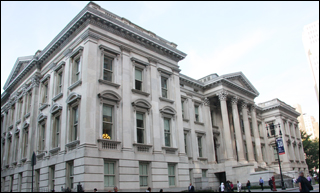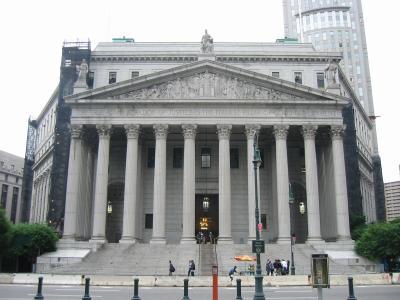Volume 2 Number 10 October 2009.
Top Ten Cyber Security Tips
From the Desk of David Badertscher
Volume 2 Number 10 October 2009.
Top Ten Cyber Security Tips
From the Desk of David Badertscher
October 19, 2009.
Source: LexisNexis
Subscription required for online access:
| 1. | The Daily Record of Rochester (Rochester, NY), October 19, 2009 Monday, COMMENTARY, 687 words, Commentary: Law schools failing their clientele, Nicole Black … aspirations to start his own criminal defense practice, but … … professional and husband of a criminal defense attorney SMungmung: “The … |
| 2. | The Daily Record of Rochester (Rochester, NY), October 19, 2009 Monday, NEWS, 1066 words, Neighborhood Focus: Rochester’s 14621 area, Colleen M. Farrell … low-income residents and criminal activity, he said. Vacant … |
| 3. | The Daily Record of Rochester (Rochester, NY), October 19, 2009 Monday, NEWS, 714 words, Rivera receives maximum in shooting of Rochester Police Officer Anthony DiPonzio, Elizabeth Stull … juvenile offender law, Penal Law §70.05, as an … … sentencing. The boy was charged with criminal possession of marijuana in the … … VIOLENT CRIME (89%); CRIMINAL LAW (89%); JUVENILE … … LEGISLATIVE BODIES (89%); CRIMINAL OFFENSES (89%); MURDER ( … |
| 4. | The Journal News (Westchester County, New York), October 19, 2009 Monday, NEWS; Pg. NaN, 440 words, Ex-New City couple face fraud charges, Akiko Matsuda LARCENY & THEFT (90%); INVESTIGATIONS (90%); … … 77%); INDICTMENTS (77%); CRIMINAL OFFENSES (77%); GRAND … |
| 5. | The New York Times, October 19, 2009 Monday, Late Edition – Final, Section A; Column 0; Editorial Desk; EDITORIAL; Pg. 26, 370 words, Oh, That Account … investigation into UBS has led to criminal investigations of scores of taxpayers. … |
| 6. | The New York Times, October 19, 2009 Monday, Late Edition – Final, Section B; Column 0; Business/Financial Desk; LINK BY LINK; Pg. 3, 920 words, Twitter and a Newspaper Untie a Gag Order, By NOAM COHEN … halls of deliberation — whether a criminal jury’s chambers or an … |
| 7. | The New York Times, October 19, 2009 Monday, Late Edition – Final, Section A; Column 0; Foreign Desk; Pg. 6, 344 words, Party Rift Grows Wider In Zimbabwe, By CELIA W. DUGGER, JOHANNESBURG … constitution, used its control of the criminal justice system to selectively … |
| 8. | The New York Times, October 19, 2009 Monday, Late Edition – Final, Section A; Column 0; Editorial Desk; EDITORIAL; Pg. 26, 1156 words, Fed Up With Albany … 89%); ETHICS (89%); CRIMINAL OFFENSES (88%); INVESTIGATIONS ( … … PUBLIC FINANCE (73%); CRIMINAL CONVICTIONS (73%); LARCENY & THEFT (68%); ARRESTS (68%); … |
| 9. | The New York Times, October 19, 2009 Monday, Late Edition – Final, Section A; Column 0; Foreign Desk; Pg. 4, 996 words, Love of Designer Clothes Adds Flair to Police Corruption Trial in South Africa, By BARRY BEARAK, JOHANNESBURG … bits of sensitive information that the criminal found useful. The case could be … … ACCESSORIES STORES (77%); CRIMINAL CONVICTIONS (75%); INTERNATIONAL … INTERNATIONAL CRIMINAL POLICE ORGANIZATION (INTERPOL) ( … |
| 10. | The New York Times, October 19, 2009 Monday, Late Edition – Final, Section C; Column 0; The Arts/Cultural Desk; THEATER REVIEW ‘THE EMPEROR JONES’; Pg. 1, 1260 words, Absolutely Corrupt, By BEN BRANTLEY … not only of his own criminal past but also of a … |
| 11. | The New York Times, October 19, 2009 Monday, Late Edition – Final, Section B; Column 0; Business/Financial Desk; Pg. 1, 1086 words, Arrest of Hedge Fund Chief Unsettles the Industry, By MICHAEL J. de la MERCED and ZACHERY KOUWE; Ashlee Vance contributed reporting. … 52, crossed the line into criminal activity. … status has been suspended. A criminal complaint filed in … |
| 12. | The New York Times, October 19, 2009 Monday, Late Edition – Final, Section A; Column 0; Metropolitan Desk; Pg. 20, 1252 words, Indicting DNA Profiles Now Critical in Old Rape Cases, By AL BAKER; Alain Delaqueriere contributed reporting. … Michael R. Bloomberg’s criminal justice coordinator. ”They shouldn’t be … … like serial car theft. Many states, including … … robbery or serial car theft. A $500,000 … … disappear. The National Association of Criminal Defense Lawyers, in … … DNA from all convicted criminals as well as from all arrestees, as is … … DNA TESTING (90%); CRIMINAL CONVICTIONS (90%); EVIDENCE ( … … 89%); FORENSICS (89%); CRIMINAL OFFENSES (89%); ROBBERY ( … … LAW SCHOOLS (78%); CRIMINAL LAW (77%); ASSAULT & … … SENTENCING (77%); LARCENY & THEFT (76%); INVESTIGATIONS (74%); … … SENTENCING (72%); VEHICLE THEFT (72%); US STATE … |
| 13. | The New York Times, October 19, 2009 Monday, Late Edition – Final, Section A; Column 0; Foreign Desk; Pg. 4, 929 words, Twin Bombings Kill 5 Commanders of Revolutionary Guards Corps in Iran, By MICHAEL SLACKMAN; Mona El-Naggar contributed reporting from Riyadh, and Nazila Fathi from Toronto., RIYADH, Saudi Arabia … promised ”that those who committed such criminal and inhuman acts will … |
| 14. | The New York Times, October 19, 2009 Monday, Late Edition – Final, Section A; Column 0; National Desk; AMERICAN ALBUM; Pg. 1, 1047 words, Once Convicts’ Last Hope, Now an Advocate for Students, By JOHN SCHWARTZ, ATLANTA … CAPITAL PUNISHMENT (89%); CRIMINAL CONVICTIONS (89%); LAWYERS ( … |
| 15. | The New York Times, October 19, 2009 Monday, Late Edition – Final, Section A; Column 0; National Desk; Pg. 12, 1131 words, Calling Story of Boy and Balloon a Hoax, a Sheriff Will Seek Felony Charges, By BRIAN STELTER; Joseph Berger and Sheelagh McNeill contributed reporting. … 89%); CHILDREN (89%); CRIMINAL OFFENSES (89%); TELEVISION … |
| 16. | The New York Times, October 19, 2009 Monday, Late Edition – Final, Section C; Column 0; The Arts/Cultural Desk; ARTS, BRIEFLY; Pg. 2, 92 words, Stage Manager Arrested, By ERIK PIEPENBURG; Compiled by RACHEL LEE HARRIS ACTORS & ACTRESSES (90%); CRIMINAL OFFENSES (85%); BAIL ( … |
| 17. | The New York Times, October 19, 2009 Monday, Late Edition – Final, Section A; Column 0; Foreign Desk; Pg. 1, 1217 words, Diverse Sources Pour Cash Into Taliban’s War Chest, By ERIC SCHMITT; Carlotta Gall contributed reporting from Kabul, Afghanistan., WASHINGTON … financing for the Taliban is criminal activity, including kidnappings and … |
| 18. | Newsday (New York), October 19, 2009 Monday, ALL EDITIONS, NEWS; Pg. A15, 55 words, CORRECTIONS GUILTY PLEAS (90%); CRIMINAL ASSAULT & BATTERY (90%); … |
| 19. | Newsday (New York), October 19, 2009 Monday, ALL EDITIONS, NEWS; Pg. A02, 525 words, Killer’s family out of neighborhood; Son convicted in 1989 slaying of Kelly Ann Tinyes; Parents had stayed in house where body was found, BY MATTHEW CHAYES AND REID J. EPSTEIN … 91%); HOMICIDE (90%); CRIMINAL CONVICTIONS (89%); FAMILY ( … |
| 20. | Newsday (New York), October 19, 2009 Monday, ALL EDITIONS, NEWS; Pg. A03, 650 words, Made-for-TV hoax; Sheriff: Balloon ploy was designed to get reality show; Boy’s parents expected to face felony charges; Probe looking to see if media outlets was involved, BY DAN ELLIOTT. The Associated Press … 90%); SHERIFFS (89%); CRIMINAL OFFENSES (89%); TELEVISION … |
| 21. | Newsday (New York), October 19, 2009 Monday, ALL EDITIONS, NEWS; Pg. A34, 144 words, NEW YORK CITY: Witnesses sought in attack on Brooklyn man, SOPHIA CHANG AND ANDREW STRICKLER POLICE FORCES (90%); CRIMINAL OFFENSES (87%); ARRESTS (73%); CRIMINAL CONVICTIONS (71%) |
| 22. | Newsday (New York), October 19, 2009 Monday, ALL EDITIONS, NEWS; Pg. A09, 974 words, Rape claim’s fallout; False accusations, as in Hofstra case, take a toll; Experts say accused, accusers pay the price, BY ANN GIVENS … Ndonye would not face criminal charges as long as she gets … … former president of the Nassau Criminal Courts Bar Association, … … Criticism of Rice’s decision The Criminal Courts Bar Association has … … youthful offender status had she been criminally charged with the misdemeanor crime of … … men warranted a criminal charge. Watson said she would have … … DOMESTIC VIOLENCE (71%); CRIMINAL OFFENSES (69%); COMMUNITY … |
| 23. | Newsday (New York), October 19, 2009 Monday, ALL EDITIONS, NEWS; Pg. A16, 408 words, SPIN CYCLE: State legislators not in rush to help guv, Dan Janison … 78%); POLITICS (78%); CRIMINAL CONVICTIONS (78%); CRIMINAL OFFENSES (78%); MEDICAID ( … |
| 24. | Newsday (New York), October 19, 2009 Monday, ALL EDITIONS, NEWS; Pg. A17, 164 words, Man charged in fatal hit-run, BY MATTHEW CHAYES … POLICE FORCES (77%); CRIMINAL OFFENSES (72%) |
| 25. | Poughkeepsie Journal (New York), October 19, 2009 Monday, NEWS; Pg. 1, 794 words, Mom haunted by fatal ’79 hit-and-run, Rasheed Oluwa … 1 [vehicle one] and the criminal liability that would determine the character of the … … John Jay College of Criminal Justice in New … |
Top Ten Stories for Week Ending October 9, 2009.
Law Practice Management Some BigLaw Leaders Still Ponder: How Low Can Associate Salaries Go?
Oct 6, 2009, 12:07 pm CDT
Histories of libraries are important because they help to both validate the existence of libraries and authenticate their records of service over time. This is why we are so grateful to our colleague Julie Gick for writing and granting us permission to post her meticulously researched article, HISTORY OF THE NEW YORK COUNTY SUPREME COURT LIBRARIES, on this blog. It includes information about both the Civil Term and the Criminal Term libraries of the New York County Supreme Court and certainly meets the criteria mentioned above regarding the importance of library histories. We encourage you to read this very informative and entertaining article
David Badertscher.
Note: This article has been updated to include additional information provided by the author on October 27, 2008
History of the New York County Supreme Court Libraries
BY Julie Gick*
Beginnings
The New York County Supreme Court Law Library’s enabling statute was Chapter 722, Laws of 1865, effective May 12, 1865, although Griswold gives a starting date of 1852. (1)
The library was first known as the New York Law Library, and justices of the Supreme Court of the First Judicial District were its trustees.
The statute required trustees of the State Library to place in the new library any duplicate books in their possession which they deemed proper and the Clerk of the Court of Appeals was required to send one copy of the printed cases and points in all Court of Appeal cases. Any person who willfully injured any of the books, furniture or property of the new library was guilty of a misdemeanor. The sum of $5000 was appropriated for the use of the library. In 1879 the librarian’s salary was $1,500. The New York Times expressed concern about the court’s expenditures. (2)
Buildings

The law library was first located at 32 Chambers Street. This building is variously known as the Court of General Sessions, Marine Court and City Court. (3) The architect may have been John McComb,Jr. who designed the new City Hall and other buildings in the area.

Architects John Kellum and Leipold Eidlitz designed the Tweed Courthouse, 52 Chambers Street at an estimated cost of $11-12 million. Also known as the Old New York County Courthouse, the library relocated to this new facility when it was completed in 1881. Over the years the library served as a lounge room, reference room, and sometimes as a courtroom. Although a handsome edifice the courthouse suffered from inadequate space and unsanitary conditions. The deaths of several justices and many clerks and court officers had been attributed to a malodorous and pestilential atmosphere pervading certain courtrooms. (4)

After the appellate branch was created effective January 1, 1896, the books and the Supreme Court librarian were assigned to the new court’s temporary quarters on the third floor at 111 Fifth Avenue corner of 18th Street. The Supreme Court Library was replaced by books from other courts, and an assistant librarian was hired to maintain its collection. In 1900 the Appellate Division 1st Department moved to its present quarters at 27 Madison Avenue. James B. Lord was the architect. He completed the building under budget for approximately $630,000. He died of a lingering illness said to be directly caused by a court proceeding. (5)

In 1907 the Emigrant Industrial Savings Bank, located at 49 Chambers Street, purchased the adjoining property at 43 – 47 Chambers Street. An architect named Raymond F. Almirall was hired to design a new building for the entire expanded lot. This was completed in 1912. At seventeen stories it was one of the tallest of the early skyscrapers in the downtown area. On March 15, 1912 the justices of the Supreme Court decided to move their offices and the library to this building. The library was located on the 12th floor. It was 25 x 100 feet and contained 5110 feet of shelving. (6)

The present day New York County Courthouse, 60 Centre Street, was completed in 1927 at an estimated cost of $30,000,000. It was modified into a hexagonal structure from the original plan. The architect was Guy Lowell who in 1913 won a competition for his striking circular design. A week before the scheduled opening, Mr. Lowell died suddenly in Madeira, Spain. This is the home of the Supreme Court Civil Term Law Library. (7)

The New York County Supreme Court Criminal Term Law Library is located in the Criminal Courts Building. This edifice was completed in 1938 at a cost of $14 million, and was designed by architects Wiley Corbett and Charles B. Meyers. Until the merger in 1962 the Law Library served as the library for the Court of General Sessions which had its own impressive history. The first Presiding Judge (then called a Recorder) was James Graham who served from 1683 to 1688. At the time it was discontinued and made part of the Supreme Court in 1962, the Court of General Sessions was known as the oldest continuously functioning criminal court in the United States. (8)

Prior to the creation of the 12th Judicial District Bronx Supreme Court Library was a part of the New York Supreme Court 1st JD. The courthouse was built in 1933 at a cost of $8 million and designed by Max Hausel and Joseph H. Freedlander. It is also known as the Mario Merola Building. (9)

The New York County Courts Public Access Law Library opened February 14, 1995 and provides legal materials and information to the public. It is located at 80 Centre Street. The building, completed 1928-1930 at a cost $6 million was designed by William E. Haugaard, the state architect, under a height restriction so that it would not overshadow the nearby courthouses. (10)
Continue reading
BY: Alison M. Smith, Legislative Attorney, Congressional Research Service (CRS)
September 14, 2009.
SUMMARY OF REPORT:
Through various means, both web based and print, we are monitoring as best we can discussions related to the ongoing health care discussions. Below is an edited and excerpted version of some information we received recently from GalleryWatch in Washington, DC. We would like to share it with you. This updates our earlier posting on the Criminal Law Library Blog
____________________________
You might have noticed over the past little while that the Senate Finance Committee has been marking up a bill to reform our health care system.( see links following this discussion to the October 1 version of the bill from the Finance Committee and to a list dated October 5, 2009 of technical corrections to that bill).
Top Ten Stories for Week Ending October 2 2009.
In-House Counsel Citigroup GC Has No Sympathy for Law Firms Seeking Premium Fees
Sep 28, 2009, 08:52 am CDT
Hearing and listening to all of the media hype of the last few days, one could be convinced that the Baucus version released a couple of days ago is the only legislation being seriously considered in the present debate. Far from it. Not only do he have at least one House version of proposed health reform legislation, we also have another Senate version which was Reported by the Senate Health Education Labor and Pensions Committee (HELP on July 15, 2009 and introduced yesterday as the Affordable Health Choices Act S. 1679 by the Senate HELP Committee Chairman,Tom Harkin.
This bill certainly represents a different viewpoint on health care reform than the Baucus bill and we hope it will help to level the playing field in the ongong debates and discussion on health care. The HELP Committee legislation does provide for a public option. Here is some of the language from TitleXXXI Affordable Health Care Choices for All Americans that appears on page 43 of the proposed legislation:
”(3) OFFERING OF COVERAGE.-
Today Sept. 16, 2009, Senator Max Baucus of Montana, the chairman of the Senate Finance Committee, released the first draft of the committee’s long awaited proposed legislation to overhaul the country’s health care system. The proposal is the result of more than a year of preparation and more than three months of intense negotiations between a small group of Democrats and Republicans led by Senator Max Baucus, Democrat of Montana, the chairman of the Finance Committee.
The following are a few highlights of interest included in this 223 page proposal:
The bill includes a slimmed down price-tag of $856 billion over 10 years. Earlier versions of the health care legislation had come in costing $1 trillion or more